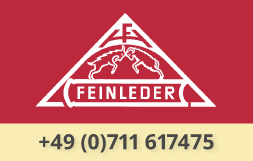- Feinleder Hoffmann /
- Articles /
- Article range /
- Goat leather /
- Alum
traditional Alum tawed goat skins / general technical introduction Glacé- Tanning
Glacé-Tanning
The Glacé tanning is nowadays one of the oldest still applied tanning procedures. It is a form of the traditional tawing ("white tanning") and is based on natural "ingredients", which basically are alum (aluminum sulfate), salt, yolk, wheat flour, greases and water.
Leather, produced according to the traditional Glacé tanning, finds its use in organ building since centuries. The skins, whilst showing finest velours finish, obtain high elasticity and a purely white color. They impress with an optimal water-storage property which compensates temperature variations with associated varying humidity. This property is of high relevance particularly in old masonry as the softness and malleableness of the Glacé leathers survives and stiffing is prevented.
An article from the research institute for leather and synthetic material ("Forschungsinstitut für Leder und Kunststoffbahnen gGmbH" (FILK)) in 2006 with the title "special leather for the construction of musical instruments" ("Spezialleder für den Musikinstrumentenbau") confirms the high relevance (despite the existence of modern alternative tanning procedures) of Glacé leather for organ building: Among others it states:
- "Todays producers have completely converted to tannings with chrome-(III)-salts and view these as superior with regard to historical procedures, particularly in the long term properties. This view however is contrary to the practical experiences of the insturments' constructors. According to adept representatives of instrument construction, leather of non-conventional production does increasingly not satisfy the desired property profile any more. (...) The huge manufactural effort and the costs for reparation and restoration of musical instruments (...) necessarily require to use a material with high-end and sustainable properties with respect to processing, usage and aging persistence as well as long life stability against environmentally induced influences (climate, immissions)."
- "The sheep leather, originally used in historical organs, was produced with a classic Glacé tanning (...). The original materials in historic instruments appear sufficiently flexible, soft and of sufficient strength sometimes even after 200-300 years."
- "(...) Moreover, the classic Glacé tanning offers an important advantage when being processed as organ leather if this has to be caulked with other components of the organ. The very hydrophile character of the original Glacé highly complies with the application of water-soluble glue (wood glue), (...)."
- "The susceptibility for mould subject to the form of tanning was tested along three sheep skins in form of a simple fouling test. (...)The tested Glacé leather did not have any fingicidal finish. The microbiocidal effect simply came from the tannin. The test approved a comparable effect of potash alum, practised from time immemorial for several substrates, with respect to modern ways of proceeding."
| Leather/Purpose | Recommendation from a technogical and material engineering's view |
| Pallet leather for organ building, wind chest, slider chest, slide seal, Pulpete, small bellows | Lamb skins, classic Glacé tanning, titanium or zircon Glacé may also be suitable (...) 0,4...0,9 (1,2) mm, high softness, hydrophile surface, Velours with consistent short pile, good dampening characters, no special expeditiousness, no corrosion by contact with metal parts, in special cases lower material thickness of ≤0,4 mm (Skiver) |
| Bellows leather for organ building, bellows, bellow zwickel, hinges | Goat and sheep skins, classic Glacé tanning (...) 0,8...1,2 mm, soft, hydrophile surface, mid expedititiousness, high consistency against persistent bending, air tightness (no imperfection on grain and flesh side) |
| Pneumatics leather, mambranes, leather covering for dadoes in organ building | Goat, kids and calf skins, hair sheep, morocco leather, goldbeater's skins, sumach tanning, dongola tannings, chromatic leather with vegetal re-tanning, chrome-alum combinations (...) low thickness (0,4 mm) as Skiver with faultless grain or fine splitted Nubuk (very fine pile) high consistency against persitent bending and thickness equality |
| Hammer head leather for restoration of pianoforte, Hammer nut leather, Schnabelleder, claviature leather | Dear ware, lamb and sheep skins, combined tannings chamois/vegetal or alum/vegetal (swedisch leather, danish leather, Cuir du Suede) (...), sharpened and unsharpened in different thicknesses, lorical tanning combined with vegetal tannin possibly suitable |
Table: Experimental recommendations (...) for instrumental leather, source: Dr.-Ing B. Trommer: "Spezialleder für den Musikinstrumentenbau", FILK 2006, S. 37
Ziegenleder, weiß, alt- Alaun, Schweinsnarben geprägt oder naturnarbig- naturell / und weicheres Neu- Alaun Haarschaf Ziegenleder (Bastard- Ziegenleder)
Artikel-Nummer:
140 / 139 oder 138 (Neu- Alaun als Haarschafleder für den Instrumentenbau)
traditionelle reine Alaungerbung, zum selbsteinfärben, konservieren, buchbinden und restaurieren
oder als säurefreie Aluminium- Synthan Gerbung (Kombinationsgerbung, Art.- Nr. 138)
Rein Alaun (Glacé) gegerbte Ziegenleder lassen sich besonders gut rückwässern.
Bei der Verarbeitung z.B. auf Holzdeckelbüchern in feuchtem Zustand lassen sich diese Leder einfach schieben und an das Original modellieren.




























